Móllienísia (Molly)
The genus "Móllienísia" is an old used name. Nowadays, all mollies are listed under the genus "Poecilia". But I'm still a bit old school when it comes to names.
Wild mollies have a wide range in distribution in South- and Central-America. They come in various sizes and coloration.
A misunderstanding with salt in a fishtank when it comes to mollies. For not all wild mollies come from salt water or brackish waters. There are species that just live in freshwater in fee nature. It really depends on what kind of molly we're talking about.


Note: There are a lot of people that just don't know the difference between Poecilia latipinna and Poecilia velifera. For they do look somewhat similar when you give them a quick look.
Besides that both species have a different location in Mexico, the maximum size of both species differ. The P.velifera reaches up between 15 - 20 cm (some become even larger) while P.latipinna sizes up between 7 - 12 cm. Also the pattern on the dorsals differ. The Poecilia velifera has small dots while the P.latipinna has got rectangular (till even short stripes) spots. But also the number of fin rays of the dorsals do differ. The number of dorsal fin rays of the P.velifera is between 17 - 21 while the P.latipinna has got a number between 11 - 15 (mostly 14).
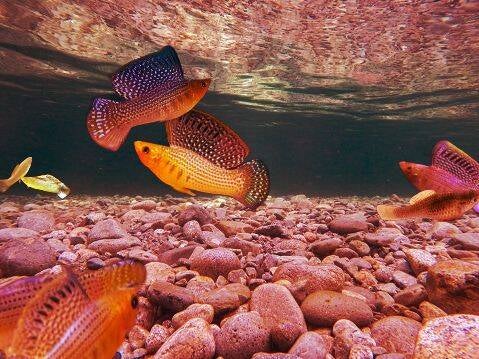
Above: Sailfin mollies from a cenote. A cenote is a water-containing cave or pool in Yucatán, Mexico. There are about 3000 cenotes in Yucatán.
As stated before, mollies come in different colors an sizes in the wild. Most people just know the more sturdy build mollies from the breeding forms we have. But in fact, in free nature also slender shaped molly species occur.
wild mollies
Liberty molly
A very slender wildform of the molly is the socalled liberty molly. The liberty molly is also known as "Poecilia salvatoris".
About the name P.gilli... rumors go that P.gilli ain't the same as P.salvatoris. In all these years that I've been keeping them, I don't see much differences between those that are sold as being P.salvatoris and P.gilli. But I do know that the coloration in the finnage of P.gilli is less present while in P.salvatoris the colors in the finnage is more intense. And with finnage, I mean the dorsal and the caudal fin. But again, both are two different molly species but look similar in size and shape. Anatomically, only the colors in their fins differ. And the location where they are found.

The origin of the liberty molly is a bit vague as well. Besides El Salvador, this molly seems to occur as well in Guatemala, Honduras, Panama and Nicaragua. It could also be that they were introduced in Guatemala, Honduras, Panama and Nicaragua at some point.

It's a gray based body that can be clear but also spotted. Typical for the males is that they have black, white and red markings in their dorsal and some red in their caudal. Females are able to have the same coloration but less and some females have clear fins. The P.salvatoris knows slender but ferm build specimens but also very slender specimens. So, if you see both versions, don't think that the more slender one is sick or something. That's just normal.
They prefer brackish water conditions and depending on the individual fish, it can be dominant or even peaceful in the behavior.

They breed easily and after a gestation of 4 - 6 weeks about 10 - 20 fry will be born. Both genders can size up to almost the same size of approx. 7 - 10cm.
It's a beautiful looking molly which for sure worthwhile to keep. But not always suitable with shy fish in one tank.
Poecilia caucana
The Poecilia caucana (also known as Cauca molly and South American molly) inhabits waterways like drainage system from Darien in Panama, Lago de Maracaibo in Venezuela and the Rio Cauca in Colombia. First described by Steindachner (1880). The subname "Caucana" refers to the Cauca river.


The Poecila caucana belongs to the somewhat smaller mollies. Males reach up to 3 cm and the females up to 6 cm. And the friendliness makes it a good community fish with other friendly fish. But despite of the fact that this may concern a smaller molly, it does need some swimming space. For it's a vivid species.

It inhabits shallow waters with sandy or mud bottoms with vegetation and a slow water current. It's a very hardy species which is able to tolerate a wide range of temperature (18°C - 28°C), salinity and anoxia (lack of oxygen). Further on, it feeds itself mainly with algae, insects and larvae. A real omnivore...
The males do look a bit similar to the males of the Limia tridens with the blue shimmer on their bodies and the yellow/orange dorsal with the small black spot. Although, these come from a different location, they are related to eachother.
Poecilia vandepolli
Poecilia vandepolli (also known as Poecilia vanderpolli arubensis) is also a smaller molly species which can be found in brackish and fresh waters of the Netherlands Antilles (also called the Dutch Caribbean). And mainly found in waters of Curaçao. First described by Van Lidth de Jeude (1887).


They do fine at somewhat higher temperatures and preferable between 25°C - 29°C. With their size of max 4,5 cm they are dwarfs. And with their more compact body shape, they can be kept in somewhat smaller tanks for they're lacking a torpedo shape. Which tells us that they won't swim in a hyper way.
From experience I do have to say that they will sex out a bit late. With these mollies you hardly see a gravid spot till even none. Which makes it harder to determine the sex when we look at a juvenile specimen. Saying this, it means that initial males will show the feminine body shapes and v-shaped anal fin for a long time before the male traits will show up. At almost full size you'll see the difference between both genders.


I've got a number of these mollies donated (2019) by a fellow breeder who caught these fish back in 2019. He was very selective in who to give these fish to. I was really fortunate to being offered these fish.
Poecilia formosa
A unique wild molly species is the Amazon molly (Poecilia formosa / Mollienesia formosa / Limia formosa). I'll explain why this molly is so unique a bit later on. The Poecilia formosa was first described by Girard (1859). This species has got a wide distribution from northeast Mexico till the south of the state of Texas (from the Rio Grande till to the Nueces river).

This molly species prefers to inhabit slow water like ditches and swamp areas. Certain areas where they also occur is most probably done by man. The hypothesis is that the origin of this molly species starts as a natural hybrid between Poecilia Mexicana and Poecilia latipinna.

Looking at the areas where the Poecilia formosa is an inhabitant, the water temperatures ranges rom 22°C - 28°C. But out of experience I do have to say that they will still do fine when kept at 20°C. But at a lower temperature they'll stop reproducing. The reproduction is where the uniqueness starts. For Poecilia formosa concerns an asexual species. Which means that the species only consists of females. In order to reproduce, they'll be in need for a male of another molly species. Using a male of a related species to establish a pregnancy is callled "parasitizing". The reproduction process the Poecilia formosa uses is called "gynogenesis". The male of a different molly species will only deliver the semen. That's the only contribution of the male. The genetic information of the male will be broken down and only the genetic information of the mother will be passed on. This means that all offspring will be female and clones of the mother. In case the genetic information of the male hasn't broken down properly (there's a slight chance that this will happen), the chance that a male offspring will be born is at hand. So, it is possible that a male offspring will be present but it's considered being rare.

Because of the unique way of reproduction, the Poecilia formosa is also used in carcinogenic research.

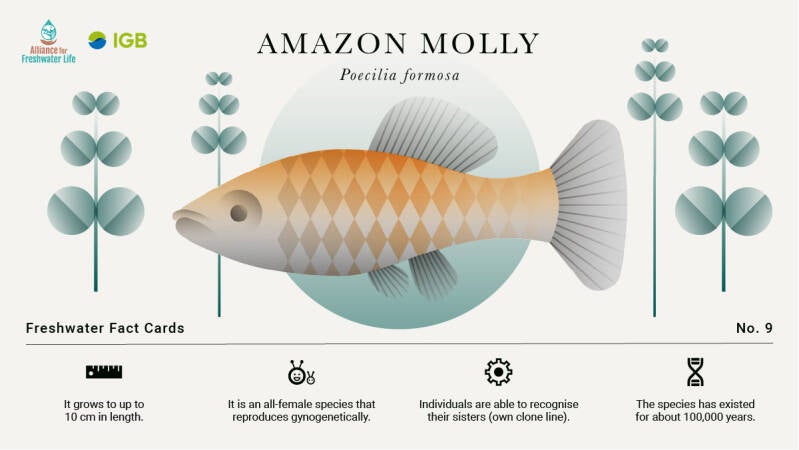
Poecilia mexicana
The Poecilia mexicana (also known as the Atlantic molly and shortfin molly) is native to both fresh and brackish waters (shallow pools, coastal lagoons and rivers with a slow water flow). They occur along the Atlantic slope of Mexico from the Rio Bravo basin into Costa Rica and Honduras. But they also occur in Guatemala, southern Belize and to the Panama canal. But the Poecilia mexicana has also been introduced elsewhere on this globe by man because of their adaptability. The ones I'm keeping are from Cabaña del Prescador (coordinates 18.26750 - 92.82951).

Below: An adult male but still needs some coloration (photo left). That may take a bit longer. He's still lacking the colored seam in his caudal. And an adult female (photo right).
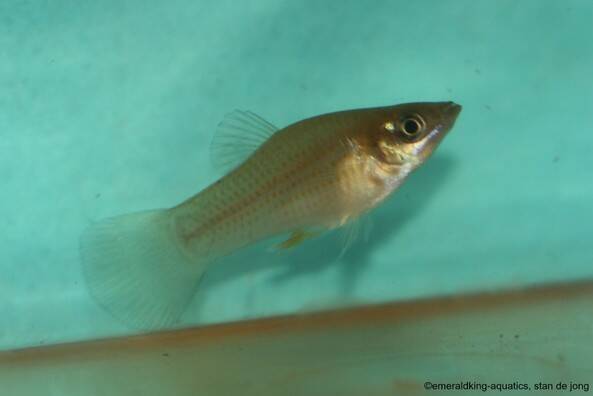
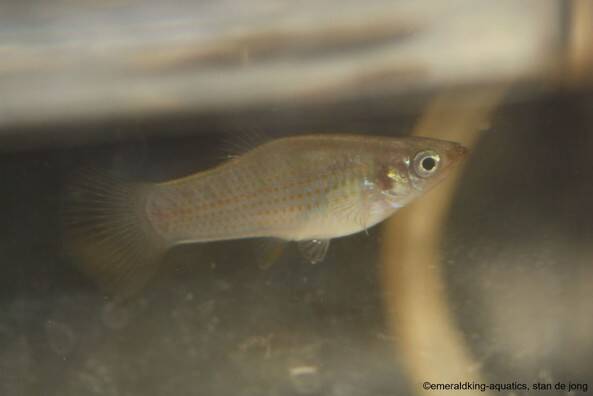
They're omnivores but do have a bigger preference for vegetable food. Although, they do eat red mosquito larvae without a problem at my place. Preferable kept at temperatures between 22°C - 28°C. But they're quite tolerant to lower temperatures as well which makes them good contenders to keep them outdoors during the better months of the year.

Above: (l) male, (r) female. They're not that shy. You can literally take them in the hand.
Environmental factors can promote phenotypic variation through alterations in the epigenome and facilitate adaptation of an organism to the environment. Although hydrogen sulfide is toxic to most organisms, the fish Poecilia mexicana has adapted to survive in environments with high levels that exceed toxicity thresholds by orders of magnitude. Epigenetic changes in response to this environmental stressor were examined by assessing DNA methylation alterations in red blood cells, which are nucleated in fish. Males and females were sampled from sulfidic and nonsulfidic natural environments; individuals were also propagated for two generations in a nonsulfidic laboratory environment. We compared epimutations between the sexes as well as field and laboratory populations. For both the wild-caught (F0) and the laboratory-reared (F2) fish, comparing the sulfidic and nonsulfidic populations revealed evidence for significant differential DNA methylation regions (DMRs). More importantly, there was over 80% overlap in DMRs across generations, suggesting that the DMRs have stable generational inheritance in the absence of the sulfidic environment. This is an example of epigenetic generational stability after the removal of an environmental stressor. The DMR-associated genes were related to sulfur toxicity and metabolic processes. These findings suggest that adaptation of P. mexicana to sulfidic environments in southern Mexico may, in part, be promoted through epigenetic DNA methylation alterations that become stable and are inherited by subsequent generations independent of the environment.
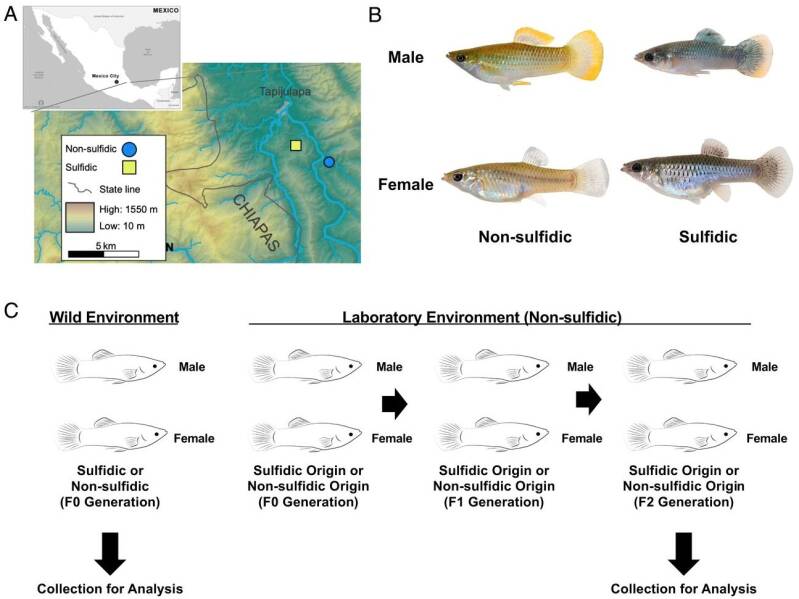
Poecilia velifera
Poecilia velifera also known a the giant sailfin molly originates from the coastal waters of the Yucatan peninsula in Mexico.
This molly species does look similar to the Poecilia latipinna. But this species is larger in size. And the dorsal becomes way higher and broader than a male of the Poecilia latipinna.


Above: An adult male (photo left). This male doesn't have his dorsal fully developed yet. It can become way higher. And an adult female (photo right). Females don't tend to get an enlarged dorsal.

Below: Two adult full grown males. Look at the gigantic dorsals (photo credits Adrian Hernandez).

But if we look at the current aquarium strains, there's a lot of crosses between Poecilia velifera and Poecilia latipinna to be found. Even crosses with Poecilia sphenops. This is also why a a serious number of those aquarium strains are hard to determine if they're pure Poecilia velifera or not.
Poecilia latipinna
Poecila latipinna is native to the Atlantic and Gulf drainages from the Cape Fear drainage, North Carolina to the Yucatán Peninsula, Mexico. But some doubts have been raised. If we have to believe I.Schulpp from the University of Oklahoma, this molly species occurs from North Carolina down to Tuxpan, Mexico and the status of populations further south than this isn't that clear.
Poecilia latipinna is restricted to coastal areas in Mississippi, Alabama, Georgia and South and North Carolina and is also found further inland in Texas, Lousiana and is abundant in Florida.

Above: A male specimen (photo credits Adrian Hernandez). Take a look at that striped dorsal.
Phenotypically, there are some differences in coloration depending on the location where they are found. And specifically referring to the males in this case. What all adult males do have is the colored seem on the caudal. From experience I just can't say that they're real fast growers. But that may differ from breeder to breeder. Although, they can reach a max of approximately 10 cm - 12 cm, they'll already be sexually mature at approximately 4 cm - 5 cm. In captivity in an average fishtank, most will reach a max of approximately 6 cm - 8cm. It's a beautiful robust and undemanding wild molly species.
Poecilia latipinna is the most hardy ones amongst the molly species when it comes to low temperatures. They withstand lower temperatures without a problem. They are also to be found in waters where certain goodeids occur. But they are also very adaptable to freshwater, brackish and marine water. All these points makes the Poecilia latipinna a suitable choice for different environments (in case you haven't made up your mind yet which kind of molly to choose).

Above: A cross section of the gonopodium of a Poecilia latipinna.
Because of the easy way of adapting to other circumstances, the Poecilia latipinna has been introduced into other waters globally.
Above: A video of the areas where the Poecila latipinna has occurred over the years.

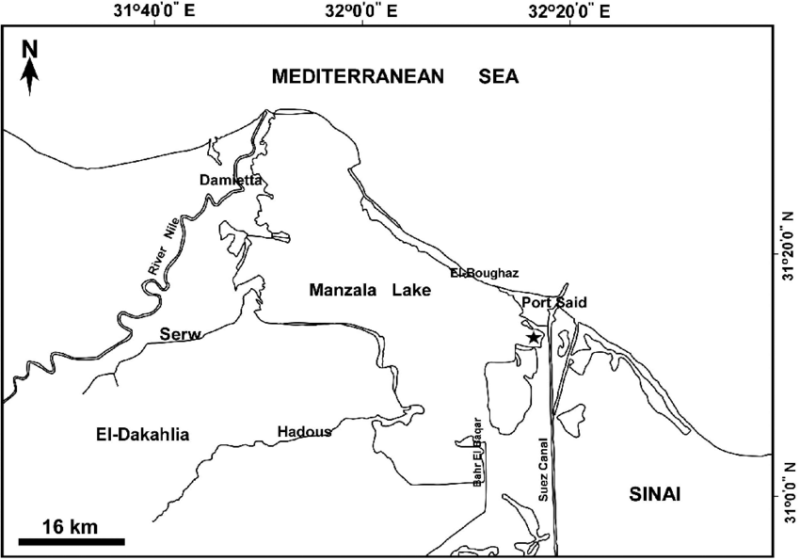
Left and above: Poecilia latipinna specimens that were collected from Lake Manzala, Egypt. This Lake contains brackish water.
The sailfin molly, Poecilia latipinna (Lesueur, 1821), is a popular aquarium fish, native to the eastern coastline of North America. It has been introduced to many countries worldwide as biological control agent and through releases from aquarium hobbyists.
Poecilia sphenops

The Poecilia sphenops is native to the Atlantic Slope of eastern Mexico from north of Veracruz City to Guatemala (Brett and Turner 1983; Miller 1983). Some authors state it ranges south to Colombia (Wischnath 1993) but that may be the result of taxonomic confusion.
The phenotype of the Poecilia sphenops differs are lot per location as can be seen in the photo above. There are more phenotypes to be found but these are 4 of them.






Alaska Hawaii Puerto Rico & Virgin Islands Guam Saipan
Below: Areas where Poecilia sphenops and Poecilia mexicana occur naturally.

As can be seen in the illustrations above, the Poecilia sphenops is widely spread. But the Poecilia sphenops is also introduced by men throughout this globe as can be seen in the illlustration below (areas marked as a yellow mark). Introductions have resulted from escapes, intentional releases from fish farms, and releases by aquarists (Lee et al. 1980 et seq.; Dill and Cordone 1997). Introduced populations have adversely affected the Moapa dace Moapa coriacea and the White River springfish Crenichthys baileyi (both endangered species) and are a potential threat to other native fishes in the Pahranagat Valley, Nevada (Lee et al. 1980 et seq.)

The Poecilia sphenops is used as a base for so many fancy mollies. Most known is the black molly. Despite of the fact that a black molly is an aquarium strain, almost black Poecilia sphenops in the wild can be found. Most of the time when one finds such an almost black specimen, it's a very black speckled specimen. But again, the black molly itself is a fancy breed of the Poecilia sphenops. In general, wild Poecilia sphenops phenotypes can range from beige-pale, brownish , olive till almost black speckled. Some have marking an others are uni colored. So, that's quite diverse...



In free nature the size of an adult Poecilia sphenops will be between 5 - 10 cm. Some exceptions become even larger. That differs per location.
Left: An adult pair that have been found in waters in Singapore.
Below: An adult male from Singapore.



fancy mollies

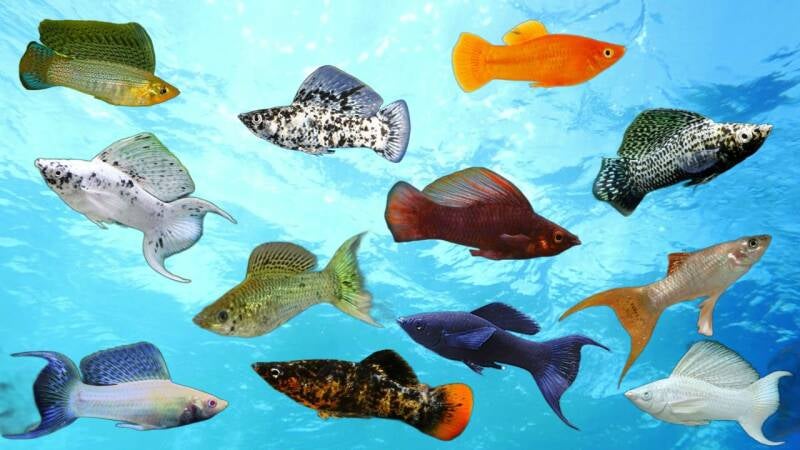
Most fancy mollies are derived from Poecilia sphenops, Poecilia velifera and Poecilia latipinna. And crosses between these three molly species. The commercial sailfins are repeatedly labeled as being Poecilia velifera but in fact they're not pure Poecilia velifera. They're crosses between Poecilia velifera and Poecilia latipinna. But also specimens that are bred with Poecilia sphenops. Neither will the commercial sailfins reach the adult size of their wild ancestors. But of course, there are some exceptions if they have the space to grow up that size. But in general, the commercial sailfins will remain smaller than they should be.

Chocolate molly
A rare fancy strain of the mollies is the chocolate molly also known as choco molly.
It's probably a mutation of the fancy strain "black molly". The true origin of this fancy strain is a bit vague. Assuming that this species is a mutation of the black molly, the chocolate molly is suppose to be also a Poecilia sphenops. But I do have to mention that this brown color has also been bred in Poecilia latipinna. Nevertheless, the first brown species were derived from Poecilia sphenops. But anyways, it's a nice specimen of a molly. I myself have got this strain back in 2014 from Peter and Astrid Raschke.
The name chocolate molly refers to the brown body colour.

Above: An adult female (photo left) and an adult male (photo right).
It differs per individual specimen wether it's totally brown or not. There are specimens which have a yellow edged tail and or fins. Some are more sand colored instead of real brown. But those sand colored ones do reproduce real brown offspring again.
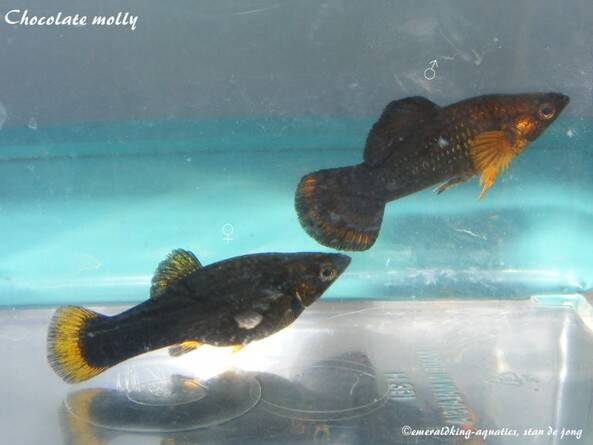
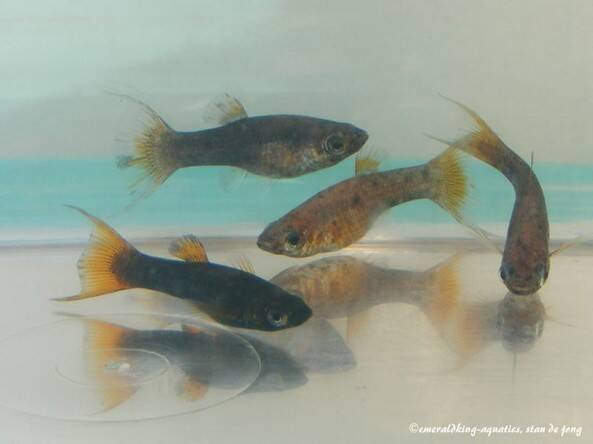
Besides this phenotype, also a lyretail version is available. Some are shown in the second photo above.
Besides the black eyed chocolate molly, there's also an albino chocolate version. These do have red eyes but they're still brown of body color (ocular albino).


Above: A group of albino chocolate mollies (Poecilia latipinna) (photo left). And an adult Poecilia latipnna with remarkable translucent fins and some pattern on them. And the uniqueness is that he's not brown based but white.(photo right).
Below: An adult albino (ocular) female chocolate molly (Poecilia sphenops).

Although, the most commercial bred chocolate mollies with red eyes are being traded in the commercial ornamental fish trade as being Poecilia sphenops, these fish have phenotypically more similarities to Poecilia latipinna than Poecilia sphenops. But fact is that also this specific strain is like all other breeding forms of mollies a hybrid between Poecilia velifera, Poecilia latipinna and Poecilia sphenops.Which would make a determination of a scientific name hard for these breeding forms. In my honest opinion, they should be labeled as "Poecilia sp. molly".For it's not a pure Poecilia velifera, Poecilia sphenops nor a Poecilia latipinna.
Red lyretail molly
A beautiful fancy molly derived from the Poecilia sphenops is the red molly. I prefer the lyretail version instead of the regular finned one.
These red mollies start off as being blonde as newborns. When they age, they blonde coloration turns slowly into orange and after a while the ornage turns into red. It's fascinating to see how the color development is proceeding.
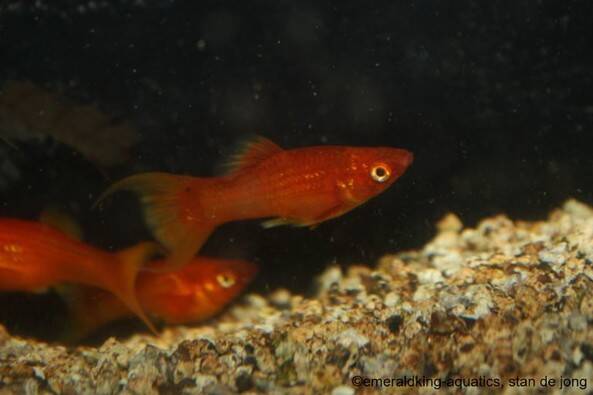
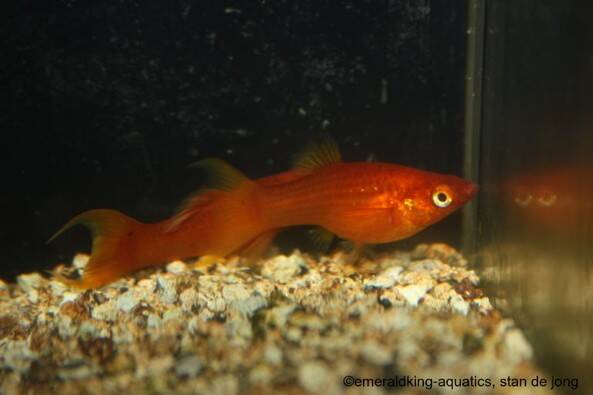
They're really coral red in phenotype. Totally different than orange.
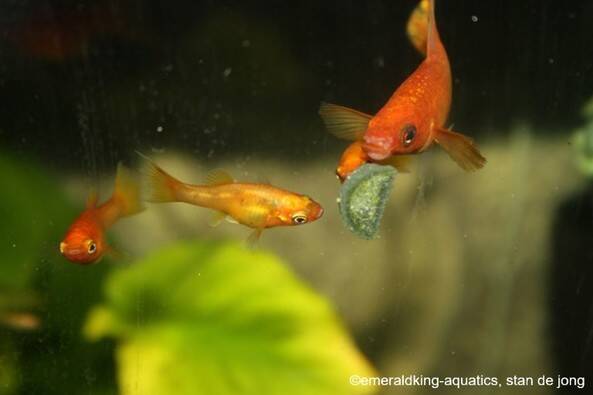

Above: And adult female and youngsters that have started changing from orange to red. Like most livebearers, also overhere the younger fish don't have the same pace in changing color.
Below: A day old fry.

Electric blue lyretail sailfin

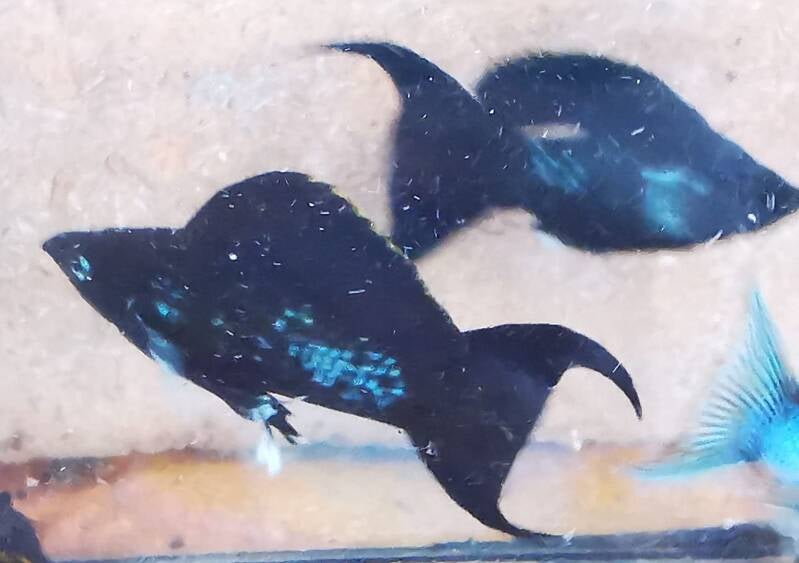
This particular blue strain has been developed in Asia. There's not that much info about how they were created. But for sure the creator of this strain has used the wild blue trait which most sailfins carry. In fancy breeds of sailfins, white, black, dalmatian and marble often show already an amount of blue as a full grown specimen (clear present or as a blue shine). Probably a matter of selection.
Below: Two full grown lyretail Poecilia velifera of a green and blue variety.


